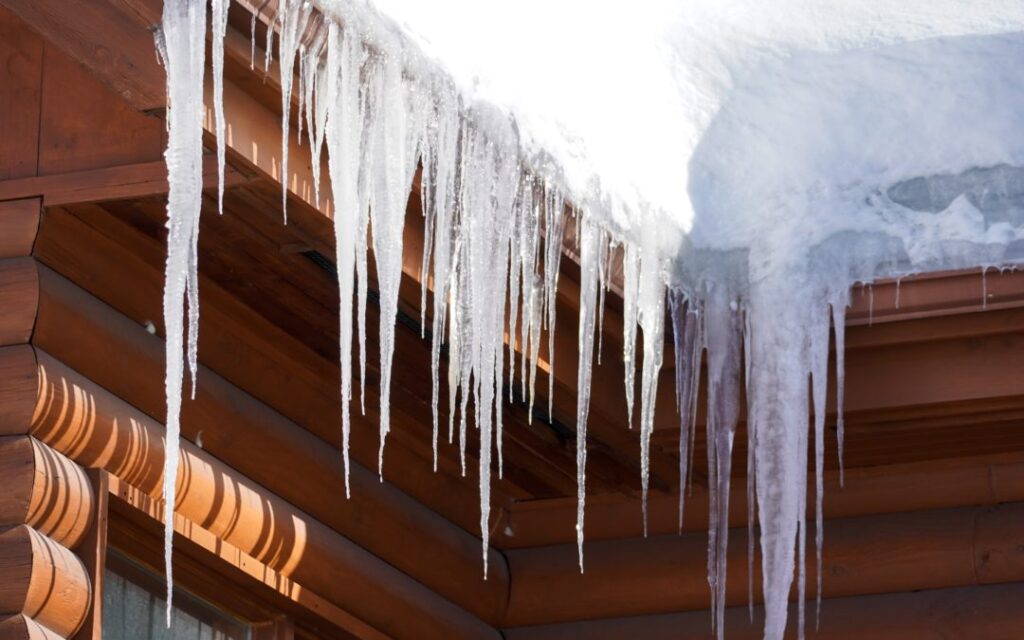Icicles on your house can mean different things. In places where the weather goes up and down around freezing, icicles form when snow melts and then freezes again. But if you have a lot of icicles or big ones, it could mean your house doesn’t keep the heat inside well.
Also, if your gutters are blocked, water can’t drain, and icicles form. Sometimes, if your roof has holes or leaks, water gets in and freezes, making icicles. It’s important to watch icicles and fix any problems to keep your house safe.
What causes icicles on houses?

Icicles on houses are formed when snow or ice melts from the warmth inside the house or from sunlight, and then refreezes as it drips off the edge of the roof. This typically occurs when the temperature fluctuates around the freezing point. Factors that contribute to icicle formation include:
Roof temperature variation
Different parts of the roof can have varying temperatures due to factors like insulation, ventilation, and exposure to sunlight. This causes snow and ice to melt unevenly, leading to water runoff.
Sun exposure
Sunlight can warm up certain areas of the roof, causing snow and ice to melt. As the water drips down the roof, it can refreeze when it reaches colder areas, forming icicles.
Insulation and ventilation
Inadequate insulation or ventilation in the attic can lead to heat escaping from the house, warming the roof and causing snow to melt. Proper insulation and ventilation help maintain a consistent roof temperature, reducing the likelihood of icicle formation.
Gutters and downspouts
Clogged gutters or improperly functioning downspouts can lead to water accumulation on the roof, which can then freeze and form icicles.
Freezing and thawing cycles
Fluctuations in temperature, where it alternates between freezing and thawing, can contribute to the formation of icicles. During warmer periods, snow and ice melt, and during colder periods, the melted water refreezes, forming icicles.
Overall, icicles are a natural consequence of the freeze-thaw cycle and the interaction between heat loss from the house and exterior temperatures.
How to interpret icicles in your house?

Interpreting icicles in your house can provide valuable insights into potential issues with your home’s insulation, ventilation, or roof condition. Here are some interpretations based on the presence of icicles:
Excessive icicle formation
If you notice a significant number of icicles hanging from your roof, especially large or thick ones, it could indicate that your attic insulation is insufficient.
Inadequate insulation allows heat to escape from your home, warming the roof and causing snow to melt, which then refreezes into icicles.
Icicles only in certain areas
If icicles are forming in specific areas of your roof while other parts remain free of icicles, it might suggest that there are localized issues with insulation, ventilation, or even structural problems.
For example, areas with poor ventilation may retain more heat and cause snow to melt unevenly.
Icicles accompanied by ice dams
If icicles are accompanied by ice dams (thick ridges of ice along the eaves), it could indicate a serious problem with your roof. Ice dams occur when melted snow refreezes at the roof’s edge, creating a barrier that prevents proper drainage. This can lead to water leakage into your home, causing damage to ceilings, walls, and insulation.
Icicles melt during the day and refreeze at night

If you observe icicles melting during the day when temperatures rise and refreezing at night when temperatures drop, it suggests normal freeze-thaw cycles.
However, if this process occurs excessively, it may still indicate issues with insulation or ventilation.
Consistent presence of icicles
If icicles are consistently forming on your roof throughout the winter, it’s a sign that you should investigate and address the underlying issues. Ignoring the problem could lead to further damage to your roof, attic, and home interior.
FAQ’s
What causes ice on a house?
Ice on a house can be caused by melting snow or ice on the roof that refreezes due to temperature fluctuations.
How can I stop icicles in my house?
To stop icicles in your house, you can improve insulation, ensure proper ventilation, and keep gutters and downspouts clear of debris.
Why do I have ice on my roof?
Ice on your roof can occur due to poor insulation, inadequate ventilation, or clogged gutters, causing melted snow to refreeze.
Why is there ice on the inside of my door?
Ice on the inside of your door may indicate air leaks or poor insulation, allowing cold air to enter and condense, forming ice.
Is it normal to have ice on the inside of windows?
No, it’s not normal to have ice on the inside of windows. It typically indicates high humidity levels inside the home or inadequate insulation around the windows.
Final Words
Icicles on your house can mean different things. Sometimes, they form because of normal weather changes, but they can also show that your house has problems like poor insulation or clogged gutters. It’s important to keep an eye on icicles and fix any issues to keep your home safe and warm.
